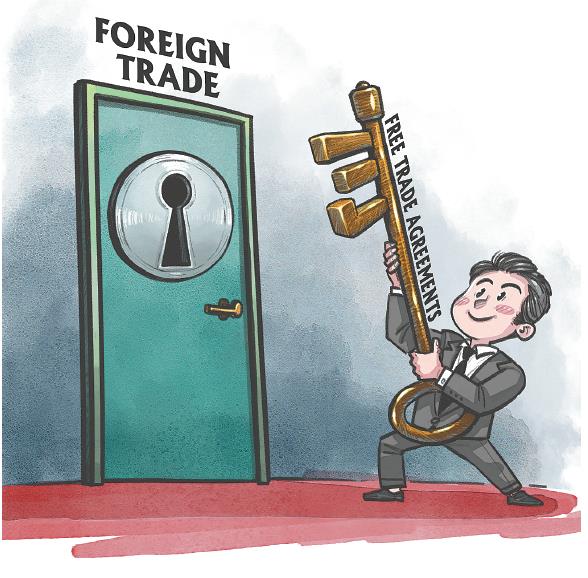China's growth gives impetus to global economy


Owing to the effects of the COVID-19 pandemic, 2020 was an uneasy year for the world, especially for the global economy. Against a background of severe and complicated situation abroad, and arduous reform tasks at home, China's hard-won positive economic performance (mentioned by Premier Li Keqiang in this year's Government Work Report) received considerable attention and appreciation worldwide.
Three major factors are key to China's efforts for sustainable growth this year.
First, thanks to the effective measures of epidemic prevention and control last year, the country's stable economic growth and social development have laid a solid foundation for its manufacturers to export more products to the global market.
With its economy entering a normalized growth track, China's foreign trade will be firmly supported by stable supply and industrial chains, ensuring supply capacity for its exports and further expanding domestic demand.
Second, there is an opportunity in the enhanced innovation ability of China's export-oriented companies. Many of them already further pushed consumption upgrade domestically and generated consumer demand through new products, technologies and business models globally in recent years.
Despite the headwinds, China's foreign trade beat expectations and registered a historic high in 2020, providing a favorable condition for a better performance this year.
Third, another opportunity arises from the government's reform and opening-up policies. As the Regional Comprehensive Economic Partnership agreement is expected to take effect by the end of this year, it will enable more than one-third of China's foreign trade goods to enjoy zero tariffs in the next stage.
Even though China has signed many free trade agreements with various partners, the RCEP platform will create fresh momentum for economic growth in China and provide new impetus to regional and even global economic recovery and growth.
One-third of the trade volume involved in China's free trade agreements will be further boosted if the RCEP is implemented in place in the future. As a result, the role of free trade zones can be further enhanced in stabilizing China's foreign trade.
Thanks to member countries' efforts to support the RCEP, the arrangement of a free-trade agreement has also been established between China and Japan for the first time. It has enhanced China's business ties with Japan, one of the world's major economies.
Moreover, based on its growth demand, China will further expand the networks of the free trade zones, and upgrade the negotiation of the existing free trade agreements during its 14th Five-Year Plan period (2021-2025).
These moves will certainly further optimize the nation's foreign trade strength and service environment.
Facing the future, the development of the Chinese economy will inevitably require a close combination of domestic demand and external demand, because the country's dual-circulation development paradigm will be a strategic response to the specific historical phase of China's economic growth and economic globalization during the 14th Five-Year Plan period and for a longer period of development.
To reach these goals, the government must continue to boost the scale of the domestic market, and use the expansion of domestic demand as a strategic tool to promote the continuous recovery of consumption. More efforts are needed to stimulate the purchasing power of consumers, improve consumption policies and the overall economic environment.
Though the final consumption contributed to about 60 percent of China's GDP growth from 2013 to 2019, it is still lower than the 70 percent to 80 percent levels seen in developed economies, data from the National Bureau of Statistics showed.
Therefore, spurring new consumption forms will improve people's livelihoods, strengthen economic resilience, accelerate the transformation to new development momentum, contribute to market-oriented industrial upgrade and market entities' expansion, as well as provide more business opportunities to foreign companies and help stabilize the global economy.
On the other hand, the expansion of the domestic market can provide stronger support for the growth of foreign trade, because a strong domestic market is the most important supporting point to cope with changes of global markets and challenges of protectionism. It can not only ensure the stability of the supply chain for foreign trade, but also increase the scale and quality of imports.
In terms of promoting the dual-circulation growth pattern, China has taken the domestic market as the mainstay to mitigate the adverse impact caused by protectionism, rather than cutting itself off from the outside world and refusing to open up. The nation has not only promoted a sustained and steady rise in domestic demand, but also enabled many foreign trade companies to seize market opportunities.
For example, many countries have strictly restricted the export of epidemic prevention materials after the outbreak. China has not adopted such strict restriction policies. Instead, it encouraged manufacturers to expand production capacity and better meet the needs of the international markets.
Thanks to the government's supportive policies, many Chinese companies raised their production capacity in a timely manner and realized the growth of related product exports to exploit new opportunities in the international market and meet new demand for anti-epidemic materials.
Innovative, green and low-carbon products and solutions, including 5G, artificial intelligence, big data, the internet of things, new energy vehicles and the next-generation industrial battery, will be the driving force of China's economic growth, particularly in the area of exports during the 14th Five-Year Plan period.
In the meantime, the country must keep an open mind to further amplify the domestic market by importing more products from other parts of the world, as the proportion of its imports of consumer goods in the total imports is still low compared to developed countries.
To make certain these moves can be implemented smoothly, it is necessary for China to actively participate in global governance and contribute "Chinese wisdom "for the reform of the World Trade Organization, so as to promote further opening-up between the domestic and international circulations from the perspective of rules.
In addition to enriching the tangible growth of the Belt and Road Initiative to build a win-win industrial and supply chain cooperation system and expand third-party markets in 2021, it is also vital for China to prepare well for either implementing or joining new free trade pacts in the future.
For example, since December last year, the Ministry of Commerce has strengthened training on the implementation of the RCEP to systematically introduce articles of the deal on goods, services, investment, rules of origin, Customs facilitation and other areas. It has also assisted local governments, industry organizations and enterprises to be familiar with RCEP rules.
As China announced that it is ready to enhance technical communication and exchanges with members of the Comprehensive and Progressive Agreement for Trans-Pacific Partnership on issues regarding joining the pact, its move will promote economic globalization and regional economic integration, in accordance with the requirements for accelerating its new growth pattern in the future.
Compared with the RCEP agreement, the CPTPP is an advanced free trade agreement with a higher entry threshold. It provides greater access to the services sector, investment protection and guarantees, more opportunities in government procurement, a facilitative framework for the digital economy and intellectual property protection.
The CPTPP, which took effect on Dec 30,2018, is a trade agreement between 11 countries: Australia, Brunei, Canada, Chile, Japan, Malaysia, Mexico, New Zealand, Peru, Singapore and Vietnam. Their aggregate GDP accounts for 13 percent of the global economy.
The writer is the vice-president of the research institute at the Beijing-based China Council for the Promotion of International Trade.
The views don't necessarily reflect those of China Daily.




































